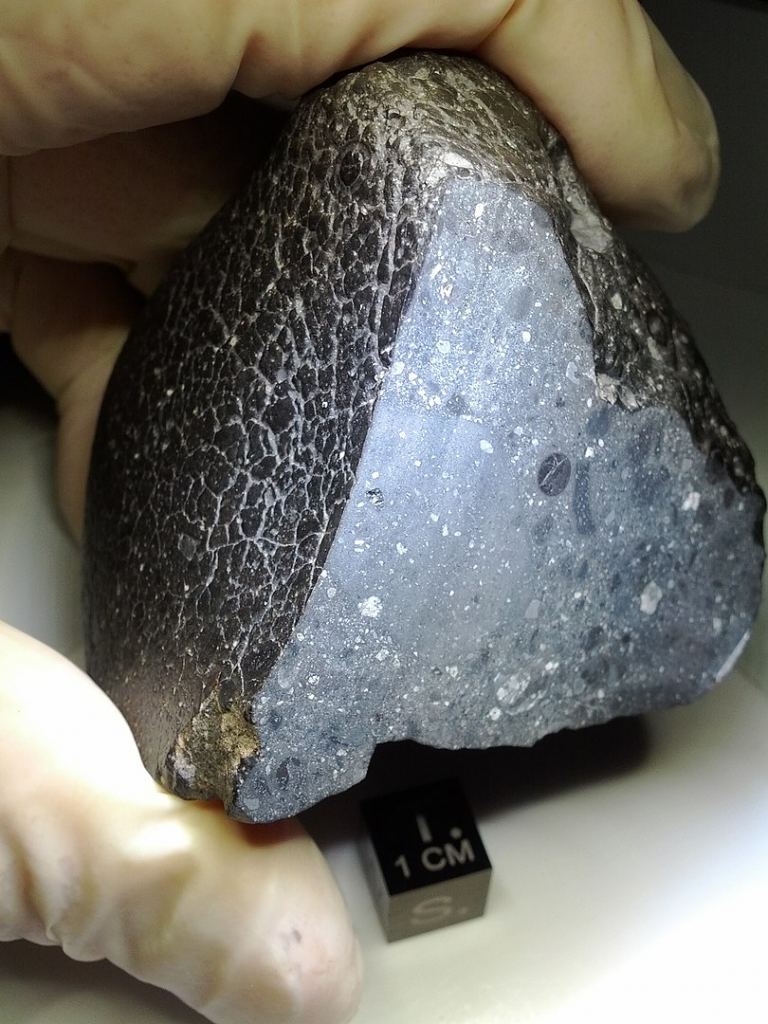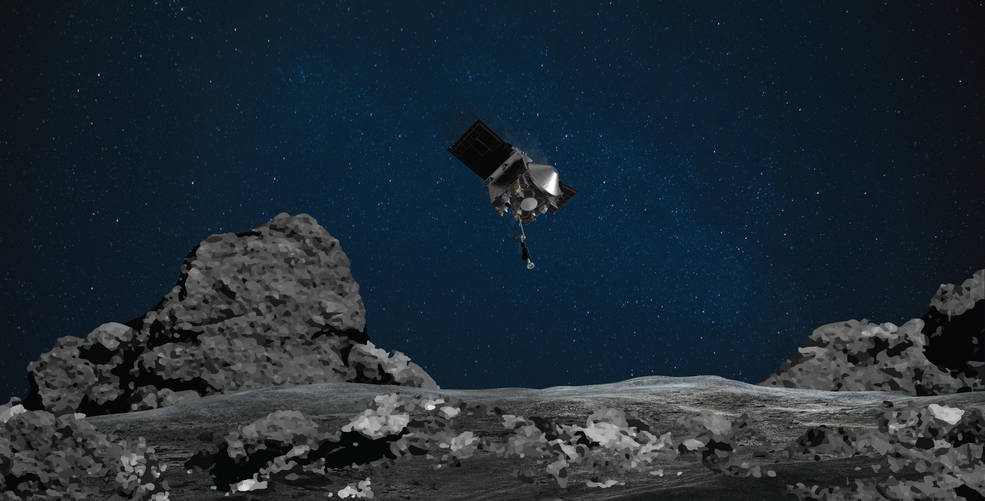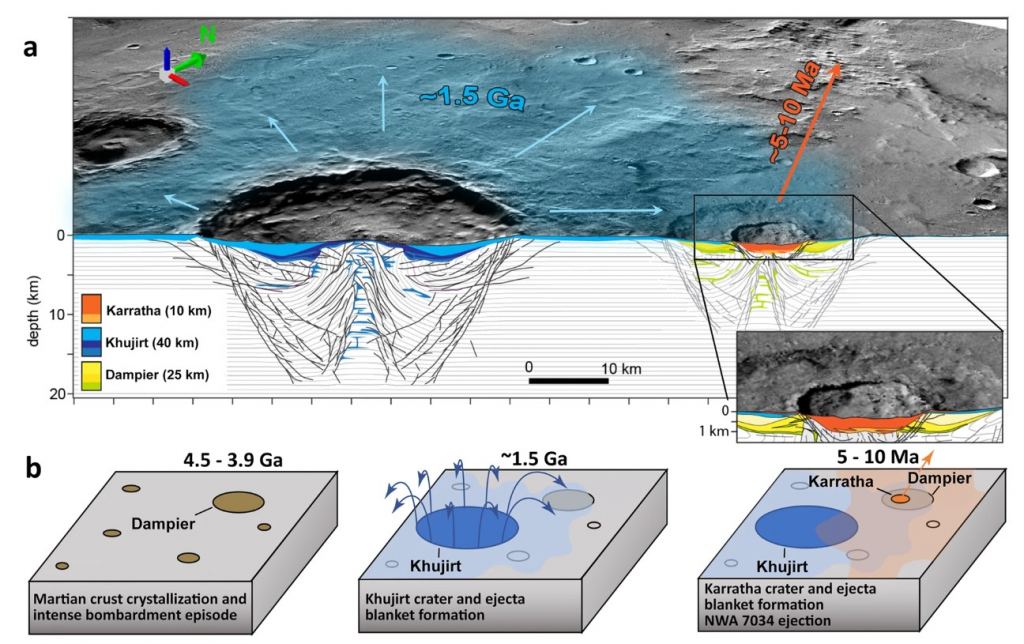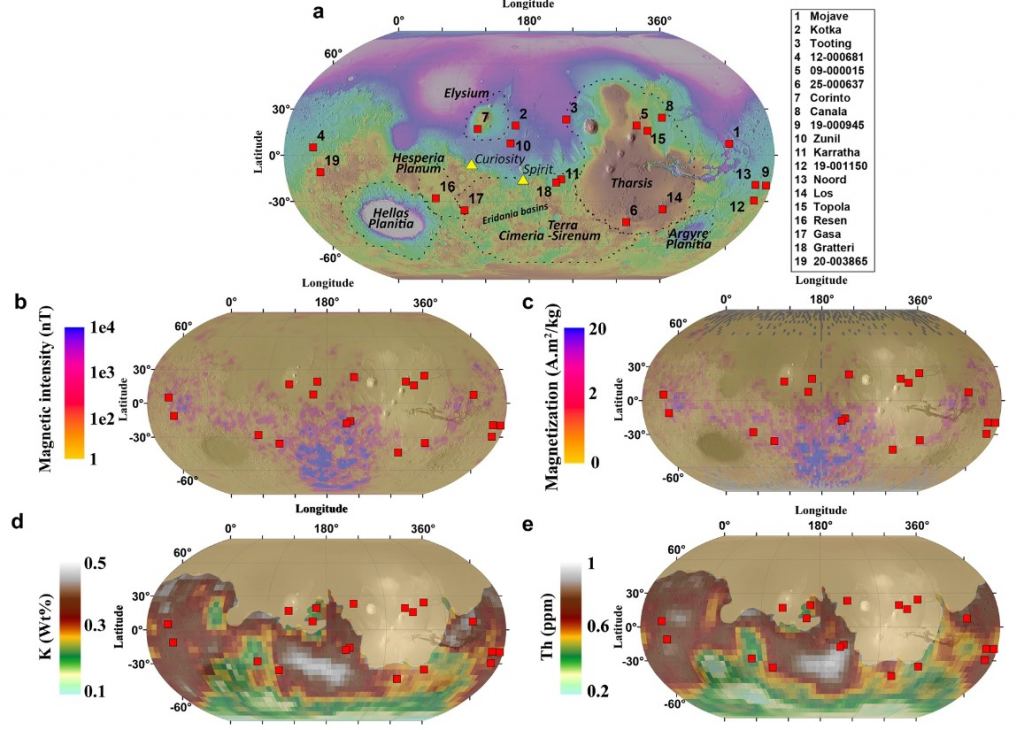If we think untangling Earth's complex geological history is difficult, think of the challenge involved in doing the same for Mars. At such a great distance, we rely on a few orbiters, a handful of rovers and landers, and our powerful telescopes to gather evidence. But unlike Earth, Mars is, for the most part, geologically inactive. Much of the evidence for Mars' long history is still visible on the surface.
That helped scientists identify the source of one of our most well-known meteorites.
The NWA 7034 meteorite is about two billion years old and was found in the Sahara Desert in 2011. It's probably the most well-known and most studied meteorite that we have. NWA 7034, also called Black Beauty, is our only sample of brecciated Martian rock. Brecciated rock is a sedimentary rock made of smaller pieces of rock with angular fragments that are held together with a matrix of fine-grained material. It contains different types of Martian rock cemented together, which makes it unique. All other Martian meteorites contain only one type of rock.
A team of researchers say they've identified Black Beauty's origin on the surface of Mars. They presented their findings in a paper titled " Early crustal processes revealed by the ejection site of the oldest martian meteorite, " published in Nature Communications. The lead author is Dr. Anthony Lagain, from Curtin's Space Science and Technology Centre in the School of Earth and Planetary Sciences.
"For the first time, we know the geological context of the only brecciated Martian sample available on Earth, 10 years before the NASA's Mars Sample Return mission is set to send back samples collected by the Perseverance rover currently exploring the Jezero crater," Dr. Lagain said.
Ask any geologist, and they'll say that rocks tell the story of a planet's history. That's why we send missions to asteroids to return samples to Earth and why NASA and the ESA are planning a sample return mission to Mars to collect samples gathered by the Perseverance Rover. With sample return missions like those, we know exactly where the samples came from, which tells researchers a lot about the source body. But up until now, scientists haven't known exactly where Black Beauty originated. The meteorite's scientific value only increases now that we know what region of the Martian surface it came from.
In general, Martian meteorites can tell us about the formation and differentiation of the Martian crust only tens of millions of years after it formed. NWA 7034 contains more diverse Martian rocks than any other meteorite. It holds a variety of igneous, sedimentary, and impact melt clasts, including the most evolved and oldest igneous clasts and zircons. "The diversity of clasts contained in the breccia makes this meteorite one of the martian samples with the most complex history, recording multiple events, from the crystallization of the martian primary crust to the ejection of the rock," the authors explain.
NWA 7034 contains the oldest Martian igneous material ever found at 4.5 billion years old. Knowing its location tells us about the history of the region it came from. And by extension, it tells us about Mars as a whole, and even about Earth.
"Finding the region where the 'Black Beauty' meteorite originates is critical because it contains the oldest Martian fragments ever found, aged at 4.48 billion years old, and it shows similarities between Mars' very old crust, aged about 4.53 billion years old, and today's Earth continents. The region we identify as being the source of this unique Martian meteorite sample constitutes a true window into the earliest environment of the planets, including the Earth, which our planet lost because of plate tectonics and erosion."
What is Black Beauty's origin story?
It started with the accretion of the planet itself, like every rock on Mars. But Black Beauty has a bit of a tangled history involving multiple impacts and ejecta blankets.
It all started back in Mars' Noachian Period, which spanned about 4.1 to 3.7 billion years ago. The Noachian is characterized by its high rate of impacts. One of those ancient impacts created a 25 km impact structure called the Dampier Crater in Mars' Terra Cimmeria—Sirenum province. Then about 1.5 billion years ago, another impact nearby the Dampier Crater created its own 40 km crater called Khujirt, and the ejecta from the Khujirt impact travelled far enough to cover the Dampier Crater.
Between 5 to 10 million years ago, a third impact followed the Khujirt impact. When that object struck Mars, it excavated a crater about 10 km in diameter named the Karratha Crater, and that impact is the direct source of Black Beauty. It was a hyper-velocity impact, powerful enough to tear Black Beauty from Mars' gravitational grip and send it into space. The breccia inside Black Beauty comes from the ejecta from the Khujirt impact.
One of the clues to NWA 7034's origin is its high concentrations of elemental Thorium and Potassium. This elemental signature was one of four criteria the researchers used to evaluate potential source sites for NWA 7034. Previous studies have shown that the meteorite likely came from Mars' Noachian Highlands, a heavily cratered region with similar geochemical qualities.
In this new research, the team also looked at three other criteria: high magnetic field density, superposition on a Noachian geological unit, and connection with material from an Early Amazonian impact (Khujirt). They came up with an initial list of 19 candidate craters as Black Beauty's source.
"The four criteria used to locate the crater source of the regolith breccia thus allow nailing down the young crater candidate population to a unique solution," the authors write in their paper. "The geological context of Karratha matches the chronology, the lithology, and the magnetic and elemental signatures of the NWA 7034 meteorite group."
The researchers relied on powerful supercomputers and an advanced crater-recognition machine learning algorithm. With these tools, the team was able to work through an extraordinarily large volume of impact crater images. The team thinks that these same tools will help them locate other source craters on Mars, leading to a better understanding of the planet's geological history.
"We are also adapting the algorithm that was used to pinpoint Black Beauty's point of ejection from Mars to unlock other secrets from the Moon and Mercury," said Professor Gretchen Benedix, paper co-author from Curtin's Space Science and Technology Centre in the School of Earth and Planetary Sciences. "This will help to unravel their geological history and answer burning questions that will help future investigations of the Solar System, such as the Artemis program to send humans on the Moon by the end of the decade or the BepiColombo mission, in orbit around Mercury in 2025."
This study also tells us where further exploration of the Martian surface will pay dividends. It pinpoints an area on Mars' surface that contains plentiful evidence from the planet's very early age.
"Our findings demonstrate that the Terra Cimmeria—Sirenum province is a relic of the differentiated primordial martian crust, formed shortly after the accretion of the planet and that it constitutes a unique record of early crustal processes. This province is an ideal landing site for future missions aiming to unravel the first tens of millions of years of the history of Mars and, by extension, of all terrestrial planets, including the Earth."
 Universe Today
Universe Today




